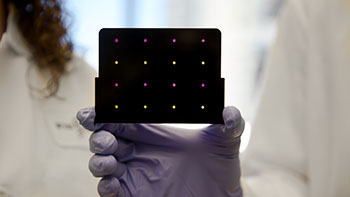CRISPR-based Technology Enables High-Resolution Zika Detection On Low-Cost Paper Discs
By LabMedica International staff writers
Posted on 16 May 2016
Building off their earlier innovative development in “programmable diagnostics”, researchers on an international, multi-institutional team recently joined efforts to quickly prototype their low-cost rapid test with the goal that it could soon be used to screen samples (blood, urine, or saliva) for Zika virus and strain identification.Posted on 16 May 2016
The team, led by synthetic biologist Prof. James Collins, Wyss Institute for Biologically Inspired Engineering at Harvard University (Boston, MA, USA) and Massachusetts Institute of Technology (USA), has developed the paper-based system for strain-specific detection as an inexpensive method to help slow the spread of Zika outbreak, and potentially of other future pandemic diseases.

Image: A black cartridge containing the innovative paper-based diagnostic for detecting Zika virus: areas that have turned purple indicate samples infected with Zika virus, while yellow areas indicate Zika-free samples (Photo courtesy of Wyss Institute at Harvard University).
"The growing global health crisis caused by the Zika virus propelled us to leverage novel technologies we have developed in the lab and use them to create a workflow that could diagnose a patient with Zika, in the field, within 2-3 hours," said Prof. Collins. "We hope a tool like this can help reduce the impact of the outbreak until a vaccine can be developed," said co-first author Dr. Keith Pardee, University of Toronto (Canada).
In 2014, the team developed a breakthrough method for embedding synthetic gene networks— which could be used as programmable diagnostics and sensors – on small paper discs. Stirred by the then-ongoing Ebola outbreak in Africa, they demonstrated a proof-of-concept color-changing diagnostic that could screen for Ebola by embedding in paper a novel kind of synthetic biomolecular sensor designed to screen for specific RNA sequences, which could mark not only genetic signatures of Ebola but also other RNA viruses (e.g. Zika, SARS, measles, influenza, hepatitis C, West Nile fever).
A major challenge was the extremely low concentration of virus normally found in blood, urine, and saliva. Now, using blood samples from monkeys infected with Zika virus as well as virus recovered from cells infected in the laboratory, the team has validated a next-generation technique that overcomes this problem.
With field-use in mind, the team designed a simple modular workflow comprising 3 steps: amplification, Zika detection, and CRISPR-aided strain identification. Once a sample’s RNA has been amplified, it is added onto freeze-dried paper discs containing biomolecular components. The droplet of amplified RNA activates the freeze-dried components so that the discs will change color to indicate a positive result for Zika virus. While the result can be read with the naked eye similar to a home pregnancy test, a specially designed electronic reader can also be used to get faster results and could, one day, quantify the amount of viral load in a sample.
If Zika is detected, the third step involves mixing a sample with a freeze-dried CRISPR (i.e. CRISPR-Cas9) cocktail and then using that mixture to wet another set of color-changing paper discs. Depending on the type of Zika strain in the sample, these discs undergo another set of visible color changes. Leveraging CRISPR’s talent for sequence recognition, this third step enables discriminate between strains whose genetic profiles differ by as little as one nucleotide – providing single-base resolution.
Although synthetic biologists and genetic engineers usually put CRISPR to work inside living cells, the team discovered that it functions just as well - and even better in some cases - when freeze -dried.
"We have tested our diagnostic systems against closely-related strains of the Dengue virus and found that within the first two steps, our system can readily distinguish Zika from Dengue," said co-first author Prof. Alexander Green, PhD, Arizona State University (USA), "Addition of the third CRISPR-based step — deploying Cas9 on a paper-based platform for the first time — only enhances the accuracy of detection. As we prepare this technology for translation, we plan to validate our system against dozens or even hundreds of clinical samples."
The ability to pinpoint a strain-specific diagnosis in the field could prove valuable to national and global health organizations for tracking the spread of a viral outbreak in real-time and for preparing containment strategies and treatment plans.
The cost-effective diagnostic platform could be tailored to identify a range of pathogens. What’s more — the method is robust and could be used to quickly respond and develop new diagnostics: "In response to an emerging outbreak, we envision a custom-tailored diagnostic system could be ready for use within one week’s time," said Prof. Collins, "We are currently pursuing multiple opportunities to secure private and public funding in order to commercialize this diagnostic system and make it available to the world’s health responders."
"The ability to recapitulate the genetic machinery of living cells in ordinary freeze-dried paper provides a way to develop revolutionary sensors and diagnostics in a fraction of the time and with higher sensitivity and specificity than more conventional assays," said Wyss Institute founding director Prof. Donald Ingber, MD, PhD.
The study, by Pardee, Green, Takahashi, Braff, Lambert et al, was published May 6, 2016, in the journal Cell.
Related Links:
Wyss Institute for Biologically Inspired Engineering at Harvard University














